How Acoma Sky City has Endured for a Millennium (and Still Won’t Go Electric)
 Acoma Sky City. (Photo: Scott Catron/Wiki Commons CC BY-SA 2.0)
Acoma Sky City. (Photo: Scott Catron/Wiki Commons CC BY-SA 2.0)
Acoma Sky City may be the oldest continuously inhabited settlement in North America, but on a scorching midday walk in July, it certainly doesn’t feel like it.
The sacred “City in the Sky” has stood sentinel atop a sandstone bluff in New Mexico since 1150, and continues to defy all that is modern today. There’s no white noise from TVs or radios, just the sound of crows circling the mesa. The blazing sun supplies all the pueblo’s light, but the adobe homes are often dark and seemingly empty, as are the narrow dirt streets. Meanwhile, the view over the surrounding valley, with its windswept red rock monoliths, is astonishing.
To live here full-time, as only 13 families currently do, is to fully inhabit an ancient village that the Acoma tribe is deeply proud of. For centuries, the only way to get up the 367-foot bluff was a hidden “staircase”–really a series of hand and toeholds–known only to the Acoma.
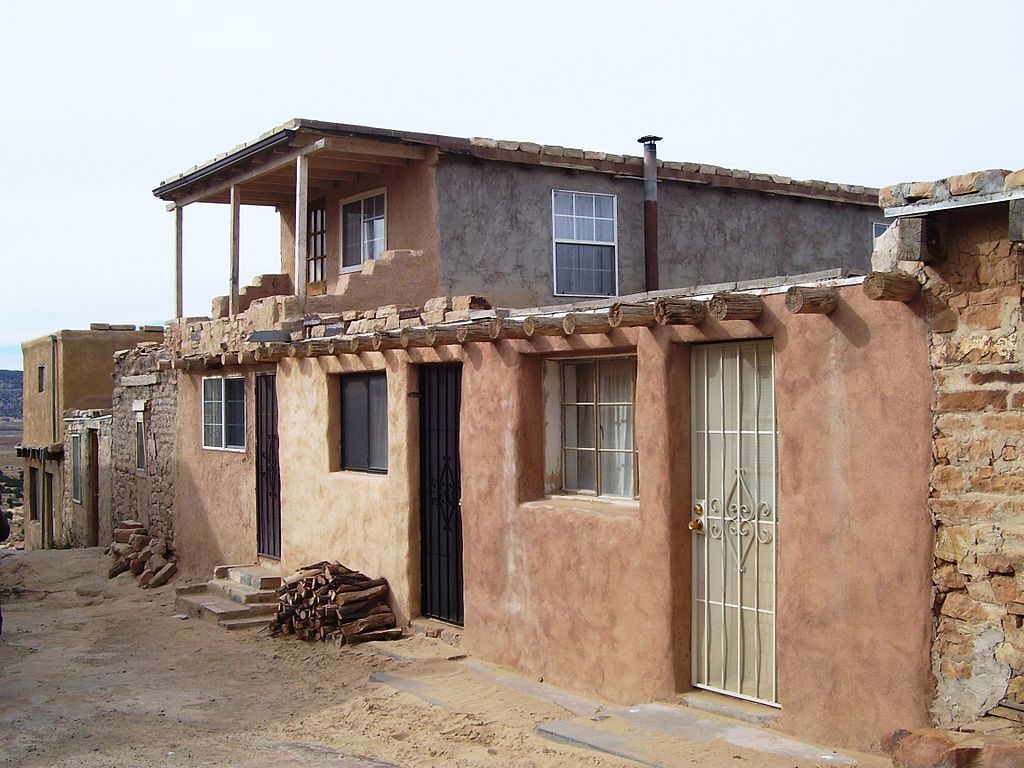 Buildings in the Sky City of Acoma Pueblo. (Photo: Beyond My Ken/Wiki Commons CC BY-SA 2.0)
Buildings in the Sky City of Acoma Pueblo. (Photo: Beyond My Ken/Wiki Commons CC BY-SA 2.0)
These days, the pueblo is entered via a sole winding road, built for Hollywood purposes almost a century ago for the 1929 film “Redskin,” which was shot partially in Technicolor, partially in black-and-white. Everything but the cobalt sky is on the warm earth color spectrum: gold, beige, sienna. There is only one tree in Sky City, offering the area’s only real shade; it juts out improbably from one of three open water cisterns that are no longer used for drinking water, as they were contaminated long ago by horses brought by Spanish colonizers.
Our tour guide is a young woman who, like most of the 5,000 members of the Acoma tribe, doesn’t live full time in Sky City. Her name tag gives a common, pretty Spanish name; she explains that long ago all the Acoma were given Spanish names, and then tells us her Acoma name: long, beautiful, and in the Keres language. She waits a beat for others to attempt the tricky pronunciation, laughs, and tells us we can call her by her Spanish name, or by “Sparkles,” which is essentially what her Keres name means.
For centuries, the Acoma have retained their traditions, culture, and names despite the best efforts of one invading force after another. Sky City’s history illuminates not only the historic traditions of the Pueblo Indians, but the often brutal relationship between native people and Spanish colonizers of New Mexico.
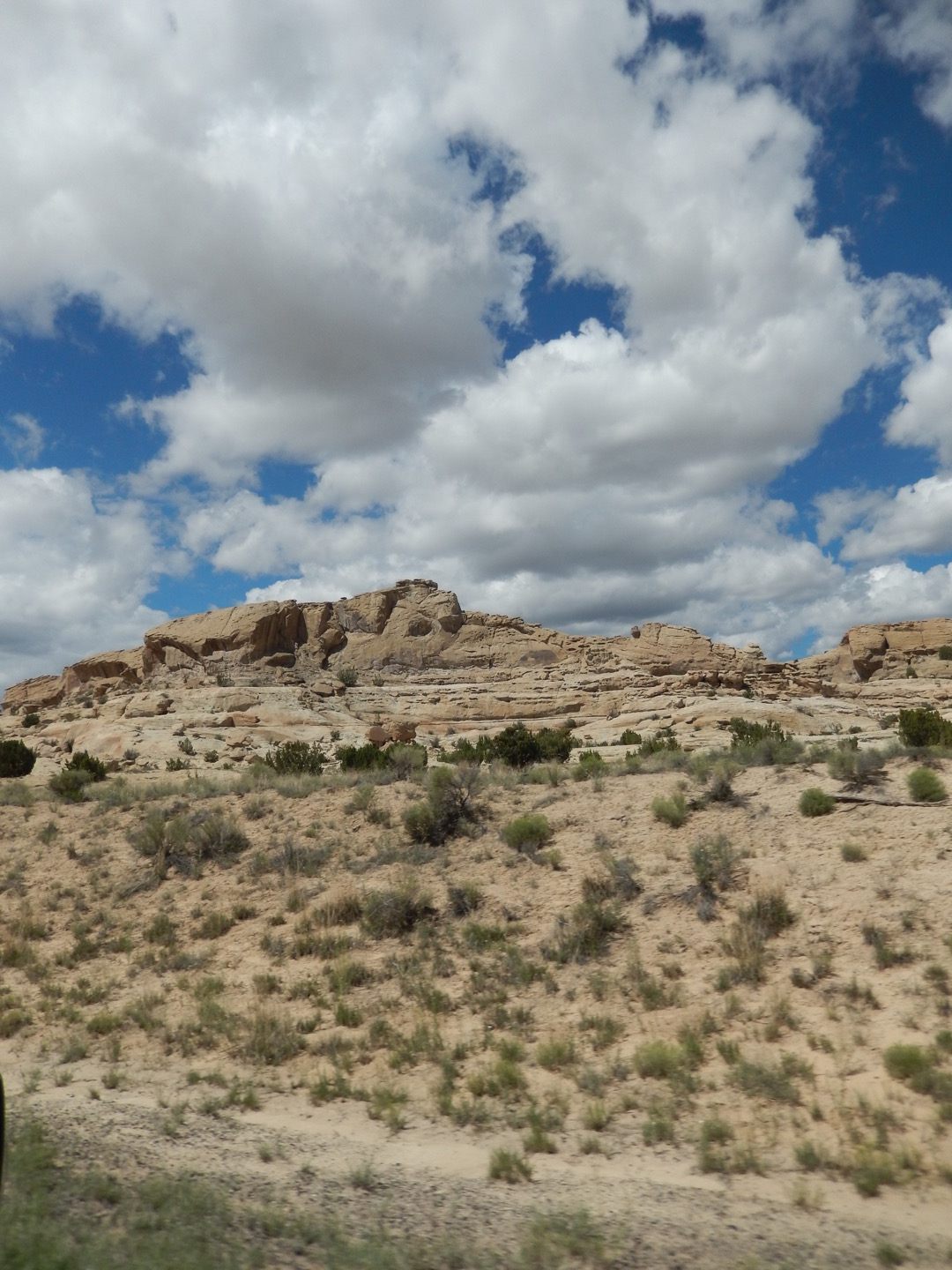 The New Mexico landscape. (Photo: Jessica Roake)
The New Mexico landscape. (Photo: Jessica Roake)
The Acoma pueblo has roots that stretch back more than a millennia, to the mysterious Hisatsinom people. The Hisatsinom (the more commonly known term “Anasazi” is actually a Navajo word for “ancient enemies” and is considered a slur by many Pueblo Indians) inhabited sites like the city of Aztec and Chaco Canyon between 700 and 1300, but when a famine ravaged their population, survivors began to spread out in search of new homes.
According to the Acoma, a group of these wanderers were told by the Gods to go south, shouting “Haa-ku!” until they came to a place where it echoed. After traveling across a long plain, the people found themselves dropped into a stunning valley studded with monoliths–what author and chronicler of the frontier Willa Cather called “vast cathedrals”–rising hundreds of feet into the air, a sacred place filled with echoes. It was in this “Haa-ku” or “place prepared” that the Acoma settled, in 1150.
They built their village atop the tallest sandstone bluff, as close to their creator, the Sun, as possible (some historians believe that Sky City’s unique elevation points to an Acoma-Aztec connection, as the Aztecs built pyramids to get closer to their Sun God.) The tribe chose to build their pueblo on top of the mesa for defensive purposes as well–it offered a perfect view of anyone approaching, and its sheer walls made surprise attacks by neighboring warlike tribes impossible.
Unfortunately for the Acoma, their gleaming city of the sun attracted the attention of people on a perpetual hunt for all that gleamed: 16th century Spanish conquistadors. It marked the beginning of centuries of oppression and brutality for the tribe.
 Acoma in the early 20th century. (Photo: Library of Congress)
Acoma in the early 20th century. (Photo: Library of Congress)
The Spaniards’ first meeting with the Acoma, in 1540, was peaceful. The second encounter, though, became infamous in New Mexico history. In 1598, Spain granted Don Juan de Oñate permission to colonize New Mexico for Spain. Invited by the Acoma to negotiate, Oñate sent a delegation of soldiers, including his nephew, to visit Sky City. Oñate’s men were immediately hostile–demanding food, breaking down houses they believed to be made of gold, and attacking Acoma women. A fight ensued, and the Acoma killed all but two of the Spanish soldiers.
Oñate retaliated by attacking the Acoma with an army, taking the mesa by cannon fire. Over the course of a fierce three-day battle known as the Acoma Massacre, the Spanish burned homes, destroyed much of the pueblo with cannon fire, and killed 800 men, women and children. Oñate then took 500 prisoners, trying and judging them in his own court. Every Acoma man over the age of 25 was sentenced to 20 years of servitude, and had their right hands and feet amputated. Younger men and women over 12 were enslaved for a period of 20 years, and children were “distributed” throughout the Spanish colonies.
Oñate’s treatment of the Acoma was cruel even by Spanish imperialist standards, and when King Philip learned of his actions, he was banished from New Mexico for life. Though Oñate is often celebrated as the founder of New Mexico, his legacy is anything but heroic for native people. When a statue of Oñate was erected in New Mexico in 1998, its right foot was promptly removed with a chainsaw. The Acoma took full and proud credit.
After their years of servitude were up, the Acoma returned to Sky City to build again. They found a new force to be reckoned with: the Catholic Church, eager to erect a glorious mission in Acoma. Friar Juan Ramirez oversaw the construction of the San Estevan del Rey Mission, now a National Historic Landmark, starting in 1629. For years, Friar Ramirez was depicted as a beloved and peaceful “civilizing” force for the people he sought to convert, but the Acoma have always vigorously disputed this depiction. “They hated that man,” says Sparkles.
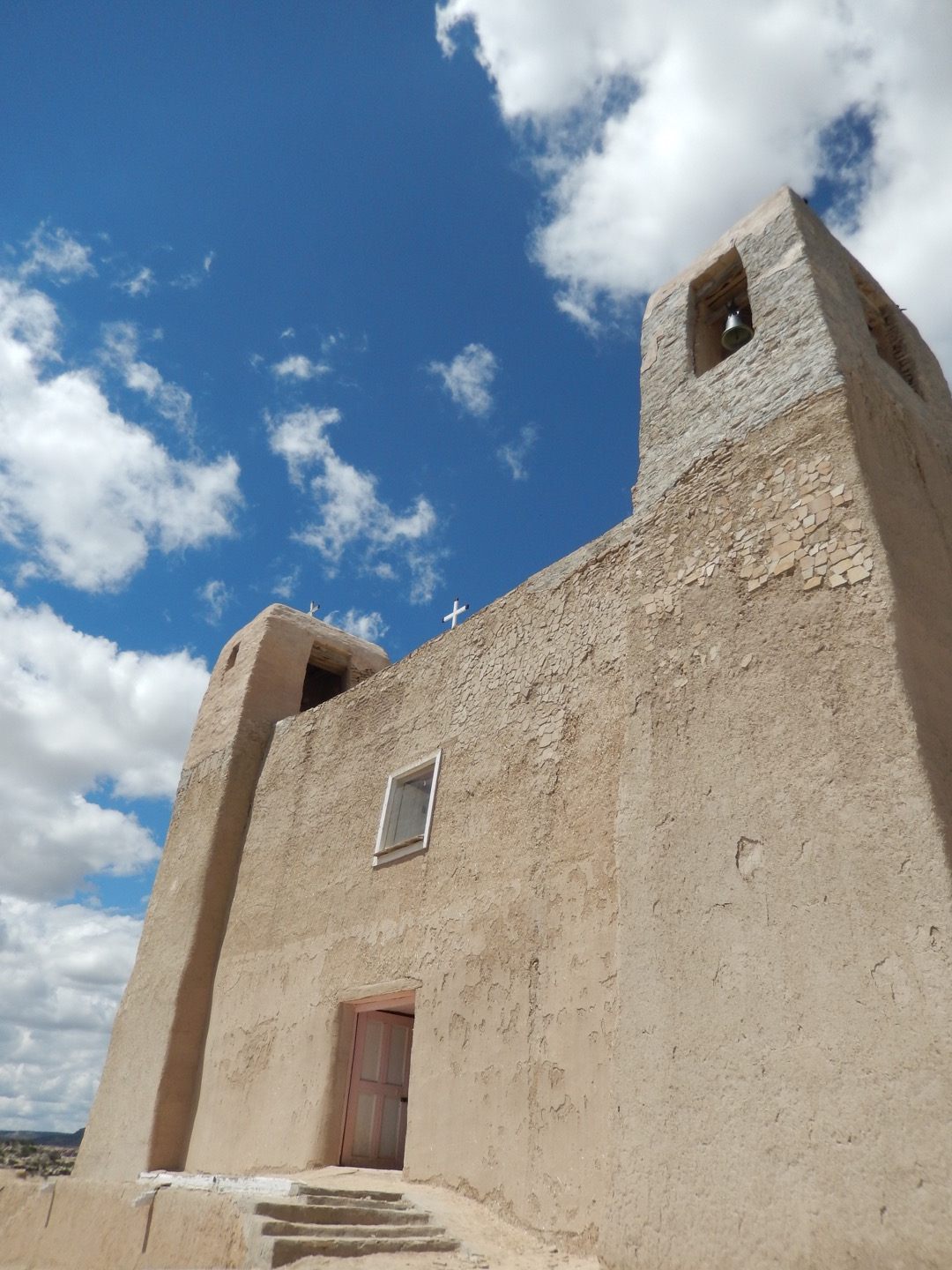 San Estevan Del Rey Mission Church. (Photo: Jessica Roake)
San Estevan Del Rey Mission Church. (Photo: Jessica Roake)
The issue was not necessarily the faith itself, as the Acoma embraced elements of Catholicism starting in the 1600s. Acoma are wary of dates since all records come from their Spanish occupiers, but the pueblo faced a massive drought in the 17th century. In their desperation, the Acoma turned to St. Estevan, the patron saint chosen for them. According to legend, the Acoma said, “if you love us so much, please end this drought.” The next day, it rained. Today, the majority of Acoma practice some combination of traditional religion and Catholicism, while five percent of the people practice only the traditional religion.
But traditional ceremonies always come first, even on Catholic feast days. Many Acoma gather in Sky City to celebrate the feast days through sacred dances and ceremonies, and adobe homes overflow with families sharing traditional chile stews, fry breads, and fruit pies with visitors.
There was no such blending to be found in 17th-century Sky City. Friar Ramirez believed that the Acoma worshipped Satan, and tried to suppress their beliefs by destroying all the sacred round kivas, or places of worship, in the pueblo. The Acoma adapted by making the kivas square and hiding them throughout the village. They can still be identified by their distinctive white ladders, pointing northward towards their ancestors, their poles sharpened to the sky for piercing clouds.
Because every part of the Catholic mission had to be brought from the valley below–some 20,000 pounds of earth and stone–the work was backbreaking for the Acoma. The Church announced that four of the beams in the church’s roof needed to be from wood that had never touched the ground, so Acoma men carried logs from Mt. Taylor 50 miles away up to Sky City, stopping and starting again if any part of the wood dropped.
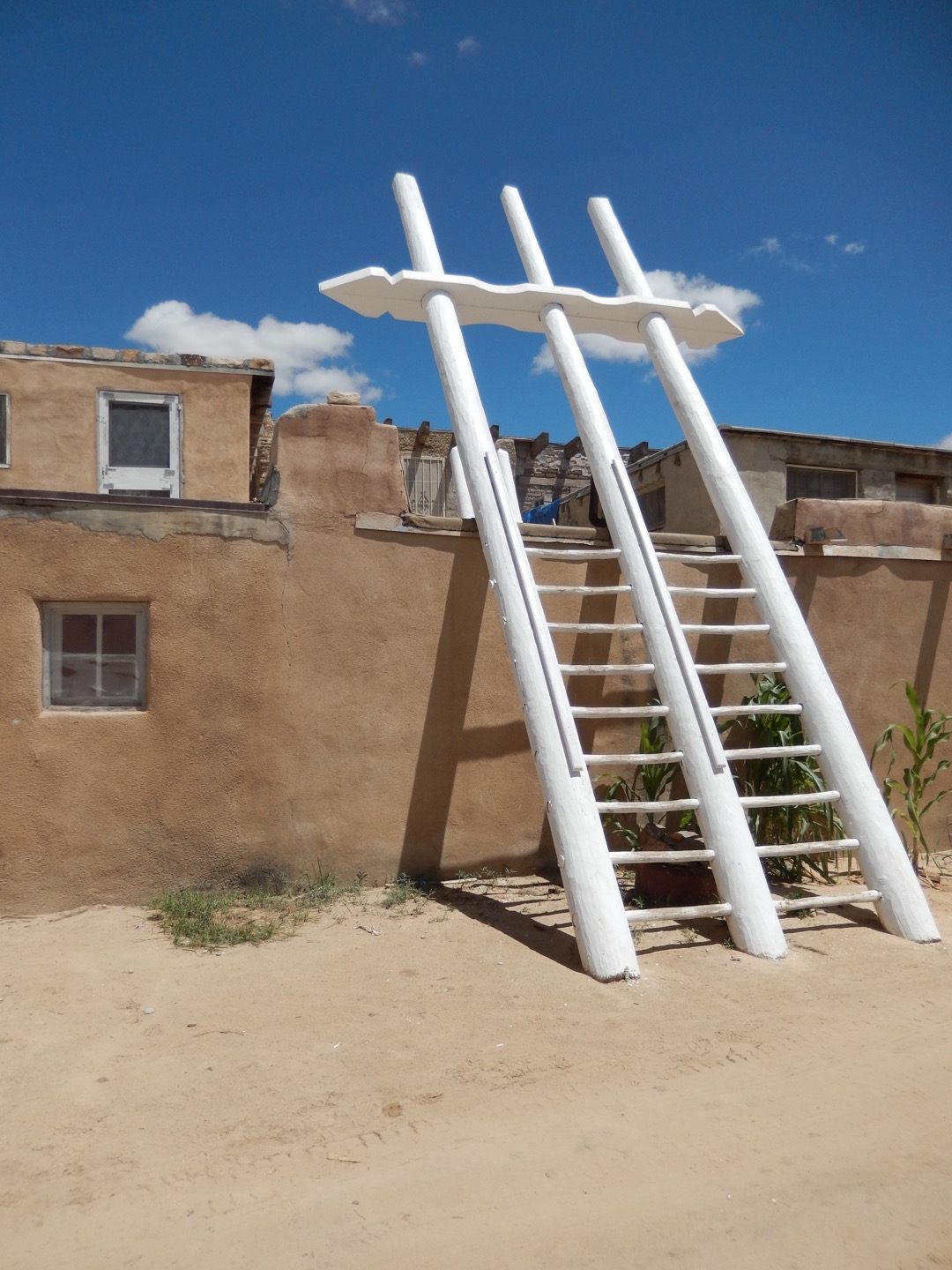 A wooden ladder leading to the entrance to a kiva. (Photo: Jessica Roake)
A wooden ladder leading to the entrance to a kiva. (Photo: Jessica Roake)
The slave labor and abuse of power used in the building of the San Estevan del Rey Mission, which Willa Cather described as “gaunt, grim, gray…more like a fortress than a place of worship,” is sharply dissected in her 1927 novel Death Comes for the Archbishop, inspired partially by Acoma: “Powerful men they must have been, those Spanish Fathers, to draft Indian labor for this great work.”
But while the site has a painful history–some Acoma still refuse to enter its grounds-–the Acoma people found small ways to integrate their traditional symbols into the church. A vibrant light pink covers the lower half of the inner walls to represent the earth, the shade like a rare kind of soil found in the valley. Rainbows painted on the walls represent the sacred rain the Acoma are always seeking, and the corn their crops. In the nave, the bannisters represent the matriarchal clans of Acoma–all property and clans are passed through the mother’s line in this society.
Sparkles points out these touches while a few Acoma people gather in the cool center of the church to chat–there are no pews for worship or priests for taking confession; they have only one full Catholic service here each year. One of the reservation dogs accompanying us on the tour gnaws on a bench, then runs out into the sun.
After the church was completed in 1642, one problem still remained in the eyes of the Spanish: it didn’t have a bell. The Church said they would gladly send one in exchange for four boys and four girls, but the Acoma refused. Spanish soldiers took the children by force, and soon a bell was gifted to the mission by the Spanish crown. Today, the bell stands in the church in memorial to the lost children.
 An aerial view of Acoma. (Photo: Marshall Henrie/WikiCommons CC BY-SA 3.0)
An aerial view of Acoma. (Photo: Marshall Henrie/WikiCommons CC BY-SA 3.0)
Nearby, there’s a walled cemetery with four layers of graves where only tribal elders and veterans are buried. Clay “warrior spirit” heads sit atop the walls; they are re-etched yearly. The wall contains one hole, made so the souls of the eight missing Acoma children can return home. Tribal elders say the hole will remain open until there is peace between all people.
In 1680, Indians all over New Mexico united and drove out the Spaniards in an unprecedented and coordinated surprise attack. The Pueblo Revolt killed 400 Spaniards, and pushed the rest from the region for 12 years. Many churches were burned, but not in Sky City. Part of this was practical– San Estevan del Rey is made of adobe that wouldn’t really burn–and part sacred: Acoma ancestors were buried in the walls of the mission.
Today, the Acoma continue to work their way back from external and internal threats to tribal life. Like many Native Americans, they have had to contend with the U.S. government, poverty, alcoholism and unemployment, among other issues. For decades, Acoma children were forcibly sent to boarding schools where their knuckles were rapped for speaking Keres. Nowadays the traditional language is taught to all Acoma children at the local schools. There are still Acoma who will not speak Spanish.
In recent years, the Acoma reservation has been able to build new medical and community centers, better schools and housing thanks to the revenue generated from a casino and tourism to Sky City.
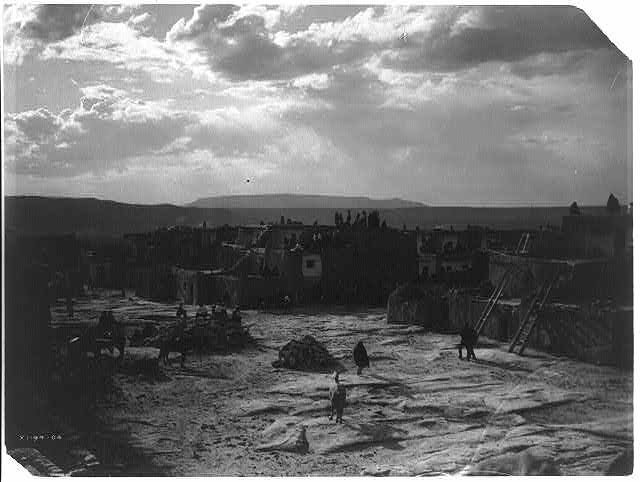 A feast day in Acoma in 1905. (Photo: Library of Congress)
A feast day in Acoma in 1905. (Photo: Library of Congress)
Sparkles points out a house near the main plaza, where the feast day dances and festivities take place. It’s not an ancient russet adobe like most in Sky City, instead it’s painted sage blue and has new windows. She is the youngest daughter in her family, and in Acoma tradition, the house is therefore hers. She is meant to care for her parents in it, and if she marries, her husband will come and live there with her.
On the narrow streets, Acoma artists have set up tables and covered them in thin, hand-coiled pottery with intricately painted geometric designs in black, white and deep ochre. Animal figures of the 12 surviving clans, in symbolic colors and patterns, share space with the pots and ceramics, and a few older ladies sell fry bread and soda. Sparkles’ cousins, toting rifles that look like toys but must be real, are climbing down the staircase to go hunting in the valley.
We look over the northern cliff, the border of Sky City that faces the 430-foot butte called “Enchanted Mesa,” and see volcanic Mt. Taylor in the distance. No one seems ready to turn in the other direction: toward the interstate that will take us all back to modernity.







Follow us on Twitter to get the latest on the world's hidden wonders.
Like us on Facebook to get the latest on the world's hidden wonders.
Follow us on Twitter Like us on Facebook